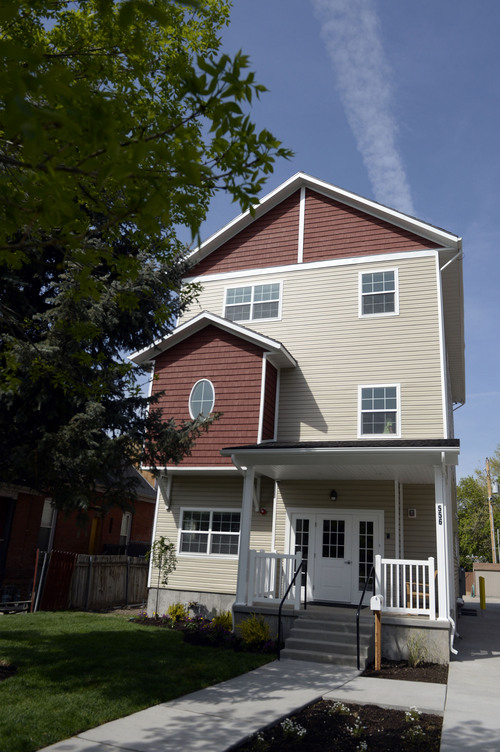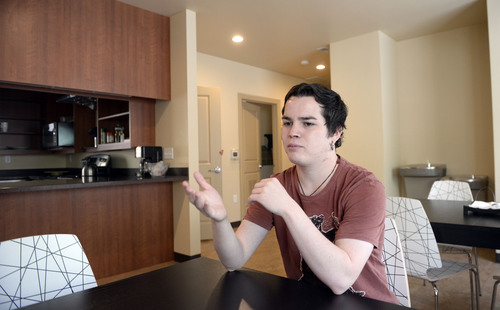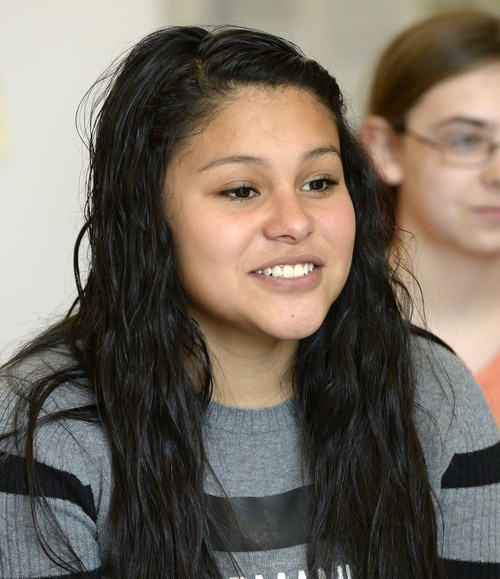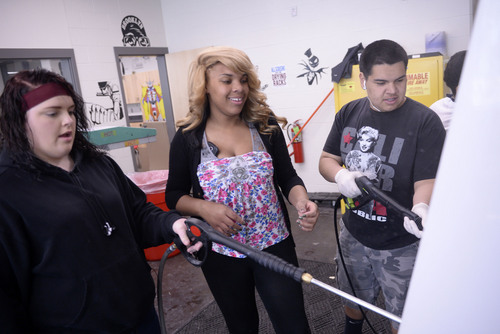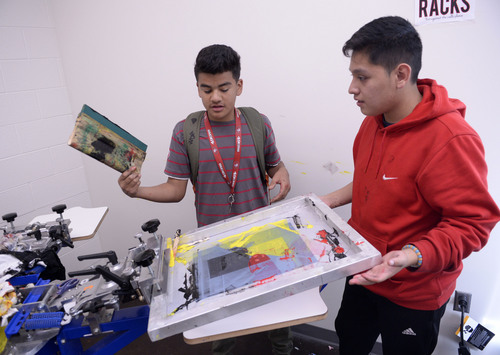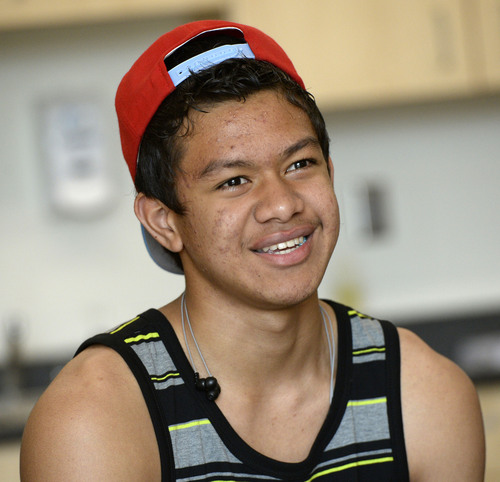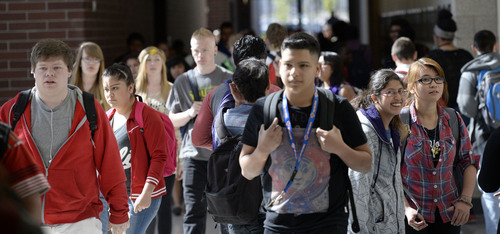This is an archived article that was published on sltrib.com in 2014, and information in the article may be outdated. It is provided only for personal research purposes and may not be reprinted.
West Valley City • Jenny Olsen did a lot of driving when her oldest son was in ninth grade.
Most days, she shuttled him from Valley Junior High to Granger High, either for his advanced math class, basketball or baseball practice.
But now that ninth grade is part of the high school, the Granger PTA president won't have to do that for her younger children.
"They're already there, and they can start taking AP [Advanced Placement classes] and doing some of those things," Olsen said. The change, she said, will give her younger children more opportunities and put them in a graduation mindset early on.
Utah has long been somewhat unusual in the nation, with more than one-third of the state's traditional high schools starting with 10th grade rather than ninth. But that's changing. Granger was one of at least half a dozen large Utah high schools this year to switch from starting in 10th grade to starting in ninth grade. And more schools likely will make similar moves.
Many Utah high schools began excluding ninth-graders in the 1980s "out of sheer economics" as student populations grew, said Sydnee Dickson, director of teaching and learning at the State Office of Education.
"For many school districts, the capacity of the buildings would not hold ninth through 12th grade," Dickson said.
Now, however, freshmen are making a comeback at many high schools as populations in some areas dwindle, and in other areas, districts realign boundaries and build new schools. Many feel the academic advantages of putting ninth-graders in high school are too great to ignore.
"It feels disjointed for students, quite often, to be receiving high school credit yet reside in a junior high setting," Dickson said. Course requirements for graduation begin in ninth grade.
—
Early results • Many, like Olsen, hope that sending teens to high school earlier will better prepare them for graduation.
"Emotionally and psychologically, when you walk into a high school as a ninth-grader, it's really hard for you to not take that seriously and think, 'I'm in high school now,' " said Ben Horsley, Granite District spokesman.
Early data from the switch at Granger seems to bear that out. Granger officials created a ninth-grade academy this year to help freshmen make the transition. Freshmen take most of their classes in one part of the newly constructed high school building, where their lockers also are located. They also take a skills class to learn study habits, planning and goal setting, among other things, said Michele Callahan, principal of the West Valley City school's freshman academy.
So far, ninth-graders have had 80 percent fewer suspensions this year at Granger than when they were in eighth grade at West Lake and Valley junior highs last year. Both of those schools are in West Valley City. Also, at this time last year, 71 percent of ninth-graders at the junior highs were on track to graduate, compared with 80 percent of ninth-graders at Granger this year. Grade point averages (GPAs) are also up among ninth-graders compared with their GPAs as eighth-graders in the junior highs.
"Ninth-graders seem to be taking high school a little more seriously now that they're actually in high school," Horsley said. "There are some students who just being in that junior high environment, they act like junior high kids."
Granger High freshman Dayna Rasmussen, 15, said it's easier to take high school seriously when you're actually attending classes there instead of at a junior high.
"In junior high, it didn't seem like you were really getting ready for that," Rasmussen said of graduation. "But in high school your teachers are pushing you every day."
—
More choices • Ninth-graders seem to behave particularly well when taking classes with older students, Callahan said.
"They don't want to be judged," she said.
Other than some playful pushing between a couple of boys, it was difficult to tell which students were ninth-graders and which were older in teacher Marcia Chalmers' graphic communications class at Granger on a recent day.
Most students sat before computers, working on designs for campaign-like buttons, while a few others worked in the project room, finishing silk screening T-shirts with original art.
It's the kind of class ninth-graders wouldn't have had in their junior highs — along with classes such as swimming, Japanese, Latin, welding and math 2 honors.
Chalmers said it's fun teaching freshmen. "The ninth-graders are so eager," she said. Plus, she said, it gives those who are really interested in graphic design a chance to get on track to eventually take her more advanced classes.
"Ninth-graders, when they come to the high school, they have access to far more classes," said Hunter High Principal John Welburn. "They have more choices to see what they might enjoy doing."
—
Drawbacks vs. advantages • Hunter High, in West Valley City, is one of a number of high schools that might soon open its doors to freshmen.
Hunter had a community meeting about the idea in October, and the Granite School District just finished a survey about the proposal. If the results show support, then the school community councils at Hunter and its feeder junior highs may make an official request to the district board to change grade configuration as soon as fall of 2015, Horsley said.
Magna's Cyprus High is holding a community meeting about adding ninth-grade later this month. Kearns High has already been approved to add a ninth-grade next school year.
Those schools are in addition to all the Canyons District high schools, which added ninth grade in the fall.
"They can start in high school taking AP classes right when they walk through the doors as ninth-graders," said Jeff Haney, Canyons spokesman. "They'll be able to take advantage of more extracurricular activities. Just from day one, they become a true member of the high school."
Canyons doesn't yet know whether its ninth-graders are performing better academically, and is waiting on results of state tests to determine that. But the district, which also converted its junior highs to grades six through eight, is already seeing results in those lower grades. Sixth-, seventh- and eighth-graders are a full grade level ahead of their peers from past years, said Hollie Pettersson, Canyons director of evidenced-based learning for secondary schools.
That's not to say, however, that reconfiguring grades doesn't have some drawbacks. Some Granite parents, for example, have been disappointed to see competitive sports suffer at the junior high level with the departure of ninth-graders. Granite schools that lost ninth-graders eliminated competitive sports against other schools, and instead expanded intramural opportunities. Also, the juniors highs have lost the career and technical education funds that came with their ninth-graders.
Some parents also expressed concern before the switch about senior boys trying to date freshmen girls, though proponents say that's an issue families can deal with at home.
The Cottonwood High community had a meeting about including ninth grade several years ago, but parents didn't like the idea, so the effort never got off the ground, Horsley said.
Still, many students and parents seem happy with the switch at Granger.
Parent Shelley Francom said her eighth-grade daughter is excited — and a bit nervous — to go to high school next school year. But Francom thinks it will be good for her and it "just makes sense."
"I think it gives them more confidence, actually, and helps them grow up a little bit to be the low man on the totem pole, so to speak, a little sooner," Francom said.
Granger ninth-grader Jonathan Faltao summed up his feelings about the switch as only a teenager can. "It's pretty chill," said the 15-year-old.
Twitter: @lschencker


